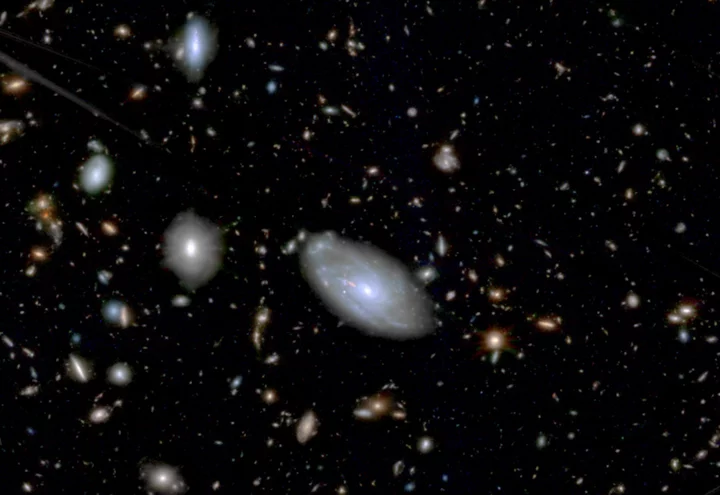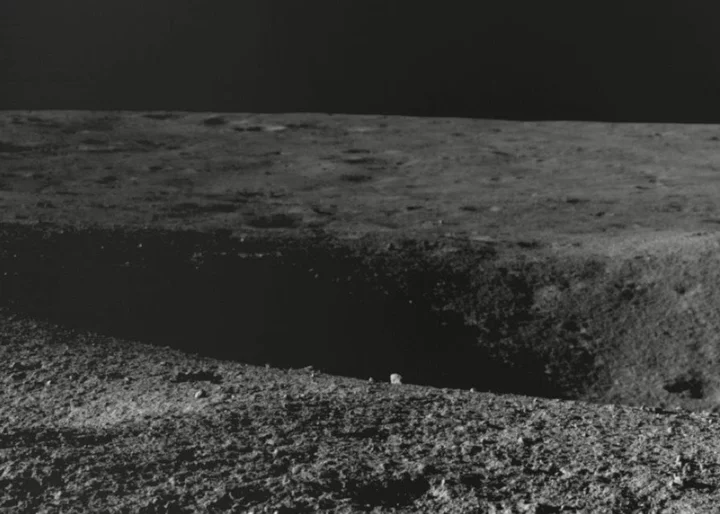The James Webb Space Telescope has enabled astronomers to see things they can't explain.
At least, not yet.
In new research from Webb — the most powerful space observatory ever built — astronomers spent 50 hours peering into the deepest cosmos, and spotted some of the first galaxies ever formed, well over 13 billion years ago. Capturing such a rich cosmic vista, with the faintest objects humanity has ever glimpsed, is an impressive feat. But the data also reveals that these primeval galaxies emitted a phenomenal amount of energy into space — 10 times more than scientists predicted.
The "key" question is how these nascent galaxies achieved this, Pablo G. Pérez-González, an astrophysicist at the Center for Astrobiology in Spain, said in a statement. Strange black holes? Lively stars? Pérez-González is an author of the research, which was published in the scientific journal The Astrophysical Journal Letters.
SEE ALSO: Webb telescope just found something unprecedented in the Orion NebulaThe Webb telescope is an extremely sensitive instrument, with the ability to capture some of the farthest away light in space. That's because Webb views a type of light we can't see, called infrared, which travels in longer wavelengths than visible light. Crucially, ancient light is stretched as the universe expands, meaning it has changed and "redshifted."
The powerful Webb, then, can see the energy created by early galaxies. The astronomers identified 44 galaxies that likely formed during the first 500 million years of the universe. Originally, this energy was emitted in the form of ultraviolet light, but it has also been stretched to infrared.
In the image below, released by the researchers, you can see:
On left: A deep field view of the cosmos with vivid spiral galaxies in the foreground and a plethora of much older galaxies in the distance. Pretty much all these objects are galaxies.
On right: Zoomed-in views of three of the highly redshifted galaxies releasing unexpected amounts of energy. "They would have been formed in the first 200 to 500 million years after the Big Bang, when the universe age was 1-5 percent of today’s [age]," a statement about the research explains.
Astronomers have simulated, with advanced computing, how the universe has evolved over billions of years, beginning with the formation of the first stars and galaxies, and eventually creating the essential organic materials for life. But no simulations predicted such extreme emissions of ultraviolet energy. What might explain it?
It could be young, lively stars, way hotter than our medium-sized sun, emitting bounties of energy into space. Or, it's possible this ancient light was created by supermassive black holes, which are objects hundreds of thousands to billions of times the sun's mass and are usually found at the center of galaxies, like our Milky Way.
But this creates another question: "Where would those supermassive black holes have come from?" asked Pérez-González.
"For now JWST is providing us with many more questions than answers, but these new lines of research are exciting."He wonders how such giant objects — with gravities so intense not even light can escape — formed so rapidly, so early in the universe's history. Most black holes are created from exploded stars, but perhaps these black holes formed another way? Questions abound.
"For now JWST is providing us with many more questions than answers, but these new lines of research are exciting,” the researchers said.
Stay tuned for more Webb answers — and questions.
An artist's illustration of the James Webb Space Telescope orbiting the sun 1 million miles from Earth. Credit: NASAThe Webb telescope's powerful abilities
The Webb telescope — a scientific collaboration between NASA, the ESA, and the Canadian Space Agency — is designed to peer into the deepest cosmos and reveal unprecedented insights about the early universe. But it's also peering at intriguing planets in our galaxy, and even the planets in our solar system.
Want more science and tech news delivered straight to your inbox? Sign up for Mashable's Light Speed newsletter today.
Here's how Webb is achieving unparalleled things, and likely will for decades:
Giant mirror: Webb's mirror, which captures light, is over 21 feet across. That's over two and a half times larger than the Hubble Space Telescope's mirror. Capturing more light allows Webb to see more distant, ancient objects. As described above, the telescope is peering at stars and galaxies that formed over 13 billion years ago, just a few hundred million years after the Big Bang.
"We're going to see the very first stars and galaxies that ever formed," Jean Creighton, an astronomer and the director of the Manfred Olson Planetarium at the University of Wisconsin–Milwaukee, told Mashable in 2021.
Infrared view: Unlike Hubble, which largely views light that's visible to us, Webb is primarily an infrared telescope, meaning it views light in the infrared spectrum. This allows us to see far more of the universe. Infrared has longer wavelengths than visible light, so the light waves more efficiently slip through cosmic clouds; the light doesn't as often collide with and get scattered by these densely packed particles. Ultimately, Webb's infrared eyesight can penetrate places Hubble can't.
"It lifts the veil," said Creighton.
Peering into distant exoplanets: The Webb telescope carries specialized equipment called spectrometers that will revolutionize our understanding of these far-off worlds. The instruments can decipher what molecules (such as water, carbon dioxide, and methane) exist in the atmospheres of distant exoplanets — be it gas giants or smaller rocky worlds. Webb will look at exoplanets in the Milky Way galaxy. Who knows what we'll find.
"We might learn things we never thought about," Mercedes López-Morales, an exoplanet researcher and astrophysicist at the Center for Astrophysics-Harvard & Smithsonian, told Mashable in 2021.
Already, astronomers have successfully found intriguing chemical reactions on a planet 700 light-years away, and the observatory has started looking at one of the most anticipated places in the cosmos: the rocky, Earth-sized planets of the TRAPPIST solar system.









